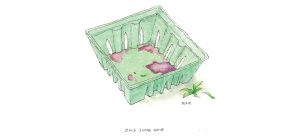
City Girl
A brief history of Borden and the ’boro
By Jane Borden
I believe identity is shaped by place, especially by the towns and cities of childhood. As a memoirist, I’ve made a (modest) career out of self-investigation. As a new parent, I’m more confused than ever. Therefore, to learn about myself, I turned to Greensboro’s past. Here’s a timeline of our shared histories.
circa 1750
• Before it was Greensboro, the area was known as Capefair, which was settled by Quaker migrants from Pennsylvania.
• Before I was Jane, I was going to be named Millie, after one of my father’s aunts. Actually, my mother’s doctor believed I would be a boy, so before Millie, I was probably Robert. Or Doug.
Late 18th century
• Greensboro becomes the third most populous city in North Carolina.
• I’ve been third place, generally speaking, most of my life. I always made the varsity teams in school, but I never started. I was good enough at improv to be placed on one of the theater’s house teams — but not on one that performed weekend nights. I published a book! It wasn’t a best-seller. You get the idea.
Late 18th century
• Sallie Stockard wrote in The History of Guilford County, North Carolina, that Greensboro was established on “an unbroken forest with thick undergrowth of huckleberry bushes, that bore a finely flavored fruit.”
• I almost always have fruit on me. Raisins, apple slices, a tangerine: You’ll find them in the side console of my car door, at the bottom of my purse, smushed into a pants pocket. I feel more in touch with Greensboro than ever.
1808
• The city’s name became Greensborough, after Nathanael Greene. Other places in America named after the same man include Greeneville, Tennessee, Greenville, South Carolina, Greensburg, Pennsylvania, a 128-foot long Army tug boat and a nuclear submarine.
• I was named after Jane Pullen, who was named for Jane Armfield. Other women in America named for Jane Armfield include Jane Preyer, Janie Fountain, Ellie Jane Preyer and Janie Vaughan.
Early 1800s
• The county seat moved from Martinville to Greensborough, deemed the natural choice on account of being the geographic center of the county. Later, a courthouse was built to hear local disputes and cases.
• My parents’ house was also deemed a natural location for a courthouse, by me, who filed countless complaints, and made arguments for both the prosecution and defense, depending on what had been asked of me or what I had been caught doing. My parents are still surprised I’m not a lawyer. But I think I understood, even then, that an actual court of law would never accept my key tactic of “wearing down” the judge.
1865
• Greensboro did witness the demise of the Confederacy when Governor Vance surrendered to Union officials in the parlor of Blandwood Mansion.
• And I am still witnessing the demise of the Confederacy, because its prevailing ideologies are slow to disappear.
1869
• The Bank of Greensboro becomes the first bank chartered by the state of North Carolina.
• When I was a freshman at Page High School, I saved money all year to buy an $85 ring at Glitters on Elm Street. It was a big green eyeball, encased in dragon claws. Needless to say, I was cool.
1890
• The Daily Record was first printed. A later iteration of it would eventually merge with another local paper, the Greensboro Daily News, and become the Greensboro News & Record.
• In 2005, I started writing about my life. But I have no employees. Still, like newspaper staffers everywhere, I wonder if I chose the wrong career.
1900
• Greensboro became known as a center of the Southern textile industry.
• One time I tie-dyed T-shirts in Girl Scouts. You better believe it was cutting-edge fashion. I also invented a few pairs of cut-off shorts in high school, but my factory foreman (mother) wasn’t pleased with the product.
1926
• WBIG begins broadcasting.
• In 1978, I started talking, and haven’t stopped. The only time I’m quiet is when I’m writing, and really that’s just talking onto paper.
1920s & 1930s
• During this time, Greensboro grew so rapidly that it experienced a housing shortage. Workers scrambled for one of the 80 to 100 affordable housing units built each year. Growth even continued during the Great Depression, when about 200 new families came each year.
• I put on 15 pounds in high school.
1957
• The Greensboro Science Center was first established, but under a different name, the Greensboro Junior Museum.
• In 1987, I asked my parents for a guinea pig. Instead, they gave me a book detailing how to care for a guinea pig. I read it and didn’t want one anymore.
1960
• The Greensboro Four sat at the segregated lunch counter at Woolworth’s on Elm Street, requesting service. The largest civil rights protests in N.C. history would take place in Greensboro over the next few years.
• The concurrence of having a child and living under our current president have simultaneously increased my capacity for empathy while increasing my awareness that “not being part of the problem” still makes one part of the problem. I have joined the organization White People 4 Black Lives and am (slowly) learning to fight effectively for racial justice. I will never have the courage of the Greensboro Four, but I strive always to be better than I was the day before.
Early 1960s
• Greensboro got its own Barn Dinner Theatre.
• I performed live comedy for seven years during the aughts. However, I am a terrible cook.
1969
• Governor Robert W. Scott ordered 600 National Guardsmen, a tank, a helicopter, an airplane and several armed personnel carriers to crush an uprising of students from Dudley High School and A&T University, who became frustrated after Dudley’s administration denied their choice for student council president on account of the candidate’s ties to the Black Power movement.
• This is where I stray from Greensboro history: Although they could occasionally be described as authoritarian, my mother’s attempts to quash my rebellions were always warranted.
1978
• The United Arts Council of Greensboro raised $550,000 to save the Carolina Theatre of Greensboro from demolition and reopen it as a community arts performing arts center.
• I rescued several pieces of furniture off the streets of Brooklyn because, free furniture. I never refurbished any of it, but the pieces definitely lent my home “history.”
1983
• Emerald Pointe water park opens in Greensboro.
• Around the same time, my family tied a rope swing to a tree in our side yard. I chipped my tooth once, while swinging, which is generally the reason I wasn’t allowed to go to Emerald Pointe. To wit, a decade later, while going down a slide at a water park on the Outer Banks, I broke my nose.
1993
• Carolyn Allen became the first female mayor of Greensboro.
• Throughout my childhood, my uncle Lucius told me I could one day be the first female president of the United States. After seeing what’s happened in the last few years, I’m relieved I didn’t try to.
2010
• The census determined that 48.33 percent of the population of Greensboro is religiously affiliated, broken down thusly: 11.85 percent Baptist, 10.25 percent Methodist, 3.97 percent Presbyterian, 3.71 percent Roman Catholic, 2.61 percent Penecostal, 1.17 percent Episcopalian, 1.02 percent Latter Day Saints, 0.96 percent Lutheran, and 11.03 percent other Christian denominations (including Greek Orthodox, Quaker, Moravian, Church of Christ and nondenominational); 0.82 percent Islam, 0.60 percent Judaism, and 0.34 percent Eastern religions.
• Similarly, I ascribe to all belief systems a little bit, but am mostly Christian. Side note: I am surprised the Presbyterian population is that small, considering how many bells are in the First Presbyterian Church’s bell choir. I got a real workout as a kid.
Current day Greensboro
• The formerly economically depressed downtown area has seen incredible redevelopment and growth, attracting new businesses, shops, bars and restaurants.
• Since college, and an early foray into sales that followed shortly after, the business areas of my brain were also neglected. Unlike Greensboro, they may never see reinvigoration.
• Greensboro is once again the headquarters of the Atlantic Coast Conference tournament.
• I have let an errant neighborhood basketball sit in a corner of my lawn for weeks.
• Gateway University Research Park, a joint project between UNCG and A&T, attracts businesses in the nanotech, high-tech, aviation and transportation/logistics sectors.
• I recently decided I should have pursued the sciences. Unlike Greensboro, it’s probably too late for me.
• Greensboro continues to be home to eight universities and colleges.
• Sigh, I used to read. And learn. Novels, science journals, current events. I had intelligent conversations too. Now I clean sippie cups.
• The I-40 & I-85 interchange is always backed up.
• I create similar logjams when I move through parties because I keep stopping to talk to people. Then again, who am I kidding? I don’t attend parties anymore.
So, what have I learned? That Greensboro remains a thriving and innovative business and cultural center. And that I’m at a bit of a stalemate. But even if there’s no longer time for me to throw cocktail parties, read books or bathe regularly, I am buoyed by my confidence in building a happy and supportive home life for my daughter. Perhaps that’s the biggest quality I can endeavor to share with Greensboro, the city that reared me: being a beautiful place to call home. OH
Jane Borden has exhausted the pertinent details of her life in this month’s column.





